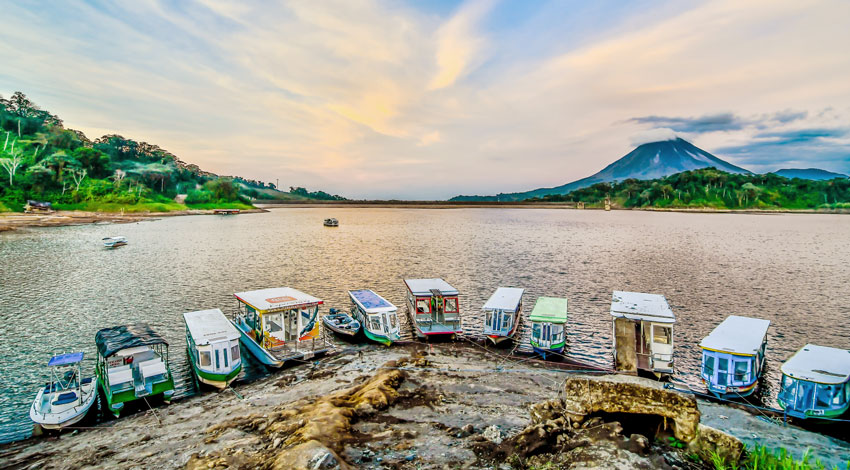My Costa Rica Journal — a Week Spent on a Road Scholar Adventure (Pt.2)
Hi There, I’m Lizzie, and I recently journeyed to Costa Rica, Road Scholar’s 2024 Campus of the Year. I thought I’d share my journal of memories and photos, so here’s part two of A Taste of Costa Rica and what it’s like to spend a week as a Road Scholar.

Lizzie and the pineapple expert
The pineapple farm.
Even with the collective knowledge and life experience of our group members, not one of us actually knew the correct method for picking out a sweet and delicious pineapple. It’s a good thing expert Danny Acuni set us straight. In a lively and entertaining presentation, Danny (machete in hand) proceeded to whack open several pineapples … while simultaneously cutting to bits everything we thought we knew about choosing a ‘ripe’ pineapple. But we do know one thing. There’s no tastier pineapple than one grown organically in Costa Rica!

Ice cream and iguanas.
Deynor took us to a local iguana rescue and family business for dessert. I loved stops like this at the local hangouts that our Group Leader knew about. Whenever Deynor added personal touches like this to our program, it was such a highlight. So stopping at an ice cream parlor and gift shop surrounded by iguanas lazing in the trees was marvelous!

At the foot of a volcano.
Reaching La Fortuna, we got our first jaw-dropping glimpse of Arenal Volcano towering over the small, bustling town. Scientists say this stratovolcano probably won’t erupt again for another hundred years, give or take. From our gorgeous cabins at Arenal Paraiso Resort, this monstrous volcano was right in front of our eyes one minute yet almost invisible the next, as passing clouds played peek-a-boo with the summit. There’s nothing quite like gazing up at the slopes of an active volcano, especially while soaking in the hot springs underneath it. (The last eruption’s volcanic gases continue to heat those thermal waters.)

The hanging bridges.
Hiking through the Mistico Arenal rainforest, we discovered hidden waterfalls and crossed several hanging bridges swaying above the treetop canopy (which can be a little unnerving until you find your footing, but there are handrails to grip). Wildlife we spotted included an eyelash viper, crested owl, double-toothed kite, honeycreeper and other exquisite tanagers (Costa Rica is like a fairyland for birding). This is a private rainforest reserve, so it’s good to know our visit helps conservation efforts by supporting the family who owns it. And no plastic water bottles are allowed in any private reserves or national parks here. This is one of the many ways Costa Rica is leading by example when it comes to saving the environment.

A little time around town.
We managed to find some free time to walk around the vibrant small town of La Fortuna. A few of us who had organically drifted toward each other had a bit of a “girl’s day out” at the quaint, locally-owned Rain Forest Café (not to be confused with the American chain), where we further bonded over some of Costa Rica’s amazing coffee before perusing the handmade crafts at a local market.
More fun with the locals.
On a visit to another local family’s farm, we got to try our hand at pounding, squeezing and extracting sugar cane used to make moonshine (among other things) … and then we downed some shots! (It was all part of the learning experience, after all.) The farmer’s adorable young daughter even joined our group to pass around some local delicacies. From there, we headed inside to learn traditional ‘basket dancing’ where several group members once again found themselves on the dance floor. This was a rollicking good time. The last activity of the night was trying our hand at making Costa Rican tortillas and eating them after they were grilled. Delicious!

Crossing Arenal Lake.
A boat ride across Arenal Lake saved us a three-hour drive by land. Being out on the water, surrounded by mountains and dwarfed by Arenal Volcano, we were able to observe how Great Egrets hunt their prey. Once we crossed this large lake, we prepared for an elevation gain … ascending 5,000 feet above sea level by bus to mountainous Monteverde.
Soda stops.
In Costa Rica, a “soda” is a place where you go to grab a quick cup of coffee, snack or lunch. These convenient roadside joints are where the locals hang out. We’d stop at a soda here and there during longer road trips, and enjoyed every one of them!

A caffeine high.
Two of our favorite things in one stop? Yes, please. We spent a delightful afternoon learning all about coffee and chocolate. The conditions at such high elevation in the mountains of Monteverde make the soil ideal for coffee plants, and we received quite an education on the methods used for planting, growing, harvesting, drying and roasting coffee beans. As an added bonus, we learned how to grind cacao and mix it with some secret ingredients to produce mouth-watering chocolate. Afterwards, we very much enjoyed tasting both. One surprising takeaway? There is basically zero difference in the caffeine levels of light and dark roast coffees!

Thanks for following along on my adventure — if you missed the first post in this series, here’s Part One of my Costa Rica experience. And stay tuned for my final post! In the meantime, if you’re curious, you can check out all of the exciting learning adventures that Road Scholar’s 2024 Campus of the Year has to offer.
